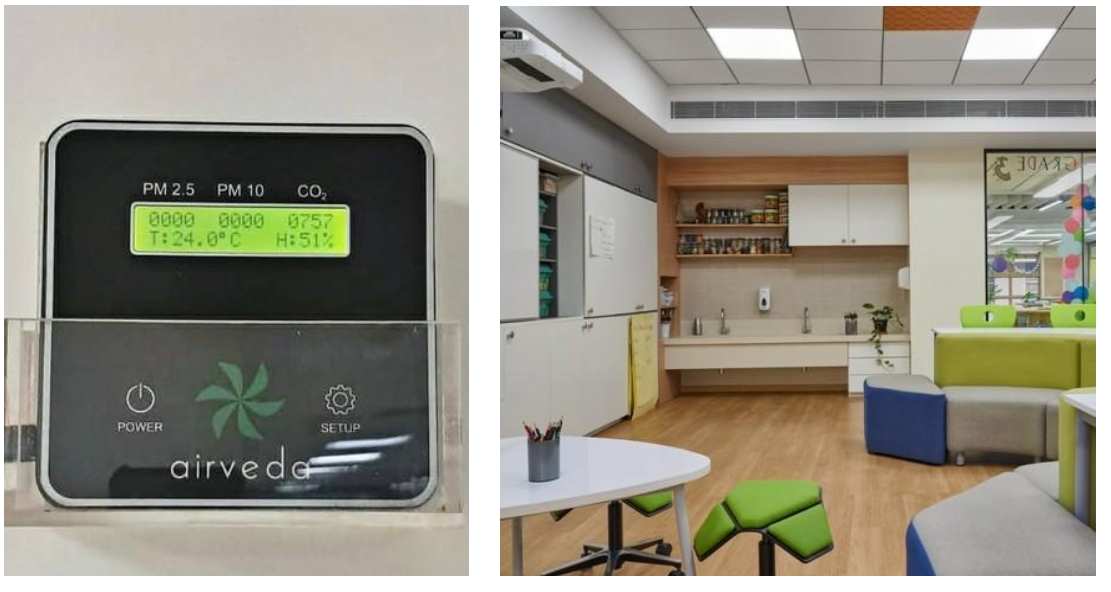Case Study - Indoor Air Quality in Schools
American Embassy School’s Use of Airveda Monitors for better Student Health

About American Embassy School
The American Embassy School (AES), New Delhi, India, is renowned for its educational excellence. Founded with the mission to provide superior education, AES offers a rigorous curriculum from pre-kindergarten through grade 12, focusing on academic rigor, character development, and global citizenship. With a diverse student body and dedicated faculty, AES fosters a stimulating learning environment that promotes critical thinking, creativity, and cultural understanding. The school's curriculum balances traditional and innovative teaching methods, ensuring students are well-prepared for an interconnected world.
AES places a strong emphasis on character development and global citizenship, instilling values such as integrity, empathy, and resilience in its students. Through various programs and initiatives, the school encourages respect and responsibility, enabling students to become better human beings.

Problem Statement
In 2015, the American Embassy School (AES) encountered a critical challenge concerning indoor air quality, driven by concerns over the deteriorating outdoor air conditions in New Delhi. This urban environment posed a threat to the health and well-being of students and staff. Acknowledging the need to safeguard its community, AES initiated a project aimed at upgrading its air filtration system to mitigate the adverse effects of outdoor pollutants.
Initially, the school's efforts led to some improvements in air quality through the implementation of filtration systems. However, these measures, while effective, were insufficient without the integration of a robust, continuous air quality monitoring system.
The absence of continuous monitoring posed a significant problem, as it prevented AES from ensuring a consistent healthy environment. Without real- time insights, the school could not effectively respond to dynamic changes in air quality, potentially exposing students and staff to harmful pollutants during peak pollution periods. This highlighted the imperative need for a comprehensive monitoring solution that would provide ongoing data, enabling proactive and informed decisions to maintain optimal indoor air conditions.

Solution
Realizing the critical importance of real-time continuous air quality monitoring, the American Embassy School (AES) launched a pilot project in 2016, beginning with the installation of two Airveda air quality monitors. Following the resounding success of this initial phase, AES expanded the initiative, deploying Airveda air quality monitors across all classrooms and common areas. Today, the school operates over 47 Airveda indoor monitors, ensuring a robust air quality management program characterized by the following key attributes:
- Comprehensive Distribution for Optimal Coverage: AES ensured thorough monitoring by deploying 47 air quality monitors throughout the campus. This extensive coverage spans elementary, middle, and high school divisions, as well as administrative offices, ensuring oversight of air quality across all sectors. The strategic placement of these monitors guarantees effective air quality management throughout the institution.
- Real-Time Indoor Air Quality Monitoring for Immediate Action: The integration of Airveda monitors provides AES with real-time data on air quality parameters, including PM2.5, PM10, and CO2 levels. Instant alerts are triggered whenever these parameters exceed predefined thresholds, enabling prompt corrective actions to mitigate any potential health risks. This real-time monitoring capability ensures that air quality issues are addressed immediately, maintaining a healthy indoor environment.
- Enhanced Problem Identification and Troubleshooting: AES has developed a centralized dashboard utilizing Airveda's secure and comprehensive APIs. This platform enables operators to conduct rapid troubleshooting and maintenance, ensuring that air quality systems function optimally at all times. The centralized dashboard facilitates efficient management and quick response to any detected anomalies.
- Understanding Environmental Dynamics: By correlating indoor air quality data with outdoor air quality data sourced from the US Embassy via Airveda APIs, AES gained insights into the significant fluctuations in outdoor air quality and its impact on indoor conditions. Continuous monitoring of these parameters allowed AES to identify and respond to causes of indoor air quality spikes, such as the return of students from breaks, and to implement timely corrective measures.
- Optimized Preventive Maintenance: The continuous monitoring system also plays a crucial role in proactive maintenance of filtration systems. Insights from the monitors guide regular washing of filters and maintenance of machine accessories, preventing potential pollution spikes and ensuring sustained optimal air quality. This preventive approach extends the lifespan of filtration equipment and maintains air quality standards.
- Increased Awareness and Engagement: The availability of real-time air quality data has not only benefited AES but also heightened awareness among students, teachers, and parents about the importance of maintaining a healthy indoor environment. This increased awareness has led to growing requests for air quality monitors in additional locations, demonstrating a broader understanding and commitment to air quality management.
- Educational Opportunities: AES has leveraged the air quality monitoring system as an educational tool, enabling students to engage with and understand air quality concepts. High school students have undertaken projects on air quality systems, fostering a deeper understanding of environmental sustainability and inspiring future initiatives. This educational integration underscores the school's commitment to holistic learning and environmental stewardship.
Conclusion
This case study highlights the American Embassy School's (AES) proactive and technologically advanced approach to mitigating air quality concerns, with Airveda playing a crucial role in achieving this target.
By integrating over 47 Airveda monitors, AES established a comprehensive and continuous air quality monitoring system that ensured a consistently healthy indoor environment. The strategic deployment of monitors, real-time data access, and advanced API integration for centralized management allowed AES to promptly identify and address air quality issues, optimize preventive maintenance, and enhance community awareness.
Airveda's technology not only safeguarded the well-being of students and staff but also served as an educational tool, fostering a deeper understanding of environmental sustainability. Through this collaboration, AES illustrated the significant role of continuous monitoring using cutting-edge technology in maintaining optimal indoor air conditions.
